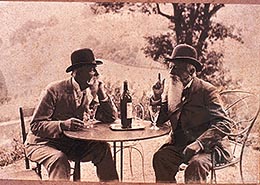 In several earlier posts, we introduced a few home winemaking terms that you may or may not be familiar with. There are many terms to learn in home winemaking, and this post, like all the previous posts, gives you a short introduction to a few of those terms to help you get started in home winemaking, or perhaps brush up on some of the terms you may not have seen in a while.
In several earlier posts, we introduced a few home winemaking terms that you may or may not be familiar with. There are many terms to learn in home winemaking, and this post, like all the previous posts, gives you a short introduction to a few of those terms to help you get started in home winemaking, or perhaps brush up on some of the terms you may not have seen in a while.
- Acid: Acid is one of the key components of wine, and it is very important to maintain balance between the acid and other components of the wine (i.e. sugar, alcohol, etc). The acid in wines comes from the natural acid present in the grapes, and sometimes from various fruit acids added to the wine throughout the winemaking process. If there is not enough acid in your wine, it’s going to taste flat. You’ll want to remedy this by adding an acid such as tartaric acid. Alternatively, if there is too much acid in your wine, it will taste rather tart and tangy, and overall an undesirable experience for most.
- Geranium: The plant? Well, sort of…if you smell geranium in your wine, you may have a problem. The distinct geranium odor is a result of spoilage caused by potassium sorbate. Sorbic acid is often used in concert with potassium metabisulfite to protect against fungal infection. It is important to note that you should never add potassium sorbate to a wine that has gone through malolactic fermentation, as the sorbate will react with the lactic acid produced from malolactic fermentation, creating a rancid odor reminiscent of geranium plants. You don’t want this to happen, as there isn’t a real fix for the fault. Be careful!
- Browning: What does it mean if your wine turns a shade of brown? Browning basically indicates that some of the phenolic compounds in your wine have been oxidized. Take care to prevent this by using the proper fermentation and storage techniques, and consider adding some sulfites such as Campden tablets or potassium metabisulfite into your wine for protection against this undesirable reaction.
- Clarity: No, this isn’t that time when you finally figured out what you were doing wrong and have a moment of clarity, this is a term used to describe the absence of cloudiness or sediment in wine.
- Flocculation: Gesundheit! Oh, sorry, I though you sneezed. Flocculation is defined as the process where some yeasts stick to one another, particularly during the shift between the exponential growth phase to the stationary growth phase. The more the yeast flocculate, the quicker they will settle out of the wine after a fermentation.
- Hot: We’re not talking about hot spiced wine here, but instead “hot” is a term to describe the taste or sensation noticed when a wine is too high in alcohol. Yes, there is such a thing as too much alcohol. Not only wines that are too hot, burn, but they also take the wine out of flavor balance.
———————————————————————————————————
Ed Kraus is a 3rd generation home brewer/winemaker and has been an owner of E. C. Kraus since 1999. He has been helping individuals make better wine and beer for over 25 years.
